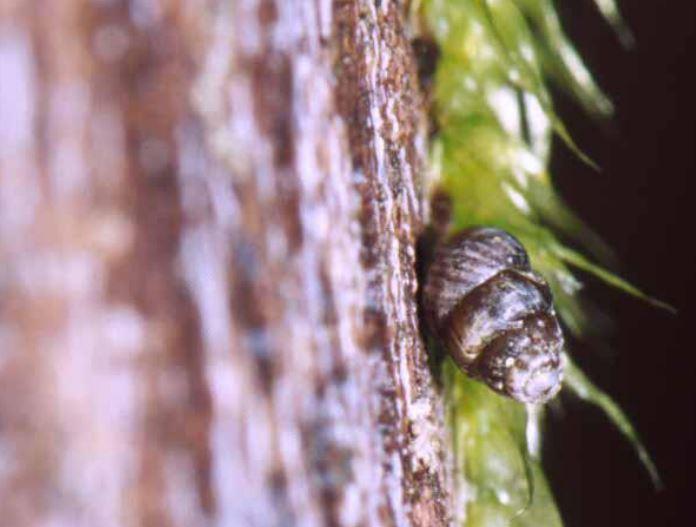Low-
Moderate
The population size of Pacific vertigo in Washington is critical and the trend points to possible extirpation (localized extinction). These small snails are very rare and found in small, isolated populations, perhaps remnants of a previously much wider range. These small populations are very vulnerable to logging, road building, fires, or other disturbances. The typical habitat for Vertigo snails ranges from moist riparian to relatively dry forests dominated by cottonwood, alder, Douglas-fir, spruce, or hemlock, depending on the species.
Description and Range
Physical description
The Vertiginidae family of terrestrial snails are minute (roughly .05 to 0.12 inch) with ovoid-shaped shells.
Ecology and life history
This species occurred in forested sites at lower elevations and may be found on trunks and lower branches of deciduous trees and shrubs, as well as among the litter beneath them. Pilsbry (1948) wrote that “some thousands of specimens were taken…about clumps of bushes in a meadow" in Oswego, Clackamas County, Oregon. A 1979 Thurston County record notes “maple, salal” as the habitat. A 1999 record from Klamath County, Oregon (Fremont-Winema National Forest) lists the habitat as a drainage through a small open meadow with an overstory of ponderosa pine and western juniper.
Land snails, including Vertiginid snails, are hermaphroditic and exchange gametes with conspecific individuals when conditions are favorable. At least some species seem to retain the fertilized eggs and give birth to small numbers of live young.
The distinctly arboreal lifestyle and mouthparts of this group of snails suggest that they feed on microorganisms growing on the surfaces of smooth-barked trees and shrubs or epiphytic lichens.
In Pacific Northwest forests, Vertiginidae snails overwinter on tree limbs, so presumably they are not killed by freezing temperatures.
Geographic range
The Pacific vertigo population is an ecotype (subdivision) of (DOCX)Vertigo columbiana (DOCX). It appears to have once been widely distributed in the Pacific Northwest, with a historical range including well-separated areas of the Cascade and Klamath provinces. It is now apparently very rare, with no confirmed sightings in the Oregon/Washington region in recent years.
There are historical records from the San Bernardino Mountains of California north through western Oregon and southwest Washington to Vancouver Island, British Columbia.
In Washington, records are in the Puget Trough and Olympic Peninsula (Grays Harbor, Thurston, and King Counties). In Oregon, the species occurred west of the Cascade Mountains, with records from Clackamas, Douglas and Klamath Counties. To date, most known records are from before 1950, with the exception of one 1979 record from Thurston County, Washington, and one 1999 record from Fremont-Winema National Forest, Klamath County, Oregon (Jordan 2013).
For a map of range-wide distribution and conversation status of Vertigo columbiana, check out NatureServe Explorer.
Climate vulnerability
Sensitivity to climate change
Low
There is limited information on the sensitivity of the Pacific vertigo snail to climate change. Typical Vertigo habitat includes moist riparian zones as well as dry forests; the Pacific vertigo snail is closely associated with primarily deciduous and occasionally coniferous trees and bushes. This species is believed to be very rare in the region. Because this species is so rare, it may be acutely vulnerable to fire, disease, or other events causing mass mortality as they may not be able to quickly rebuild populations.
Exposure to climate change
Moderate
- Increased disease outbreaks
- Altered fire regimes
Conservation
Conservation Threats and Actions Needed
- Resource information collection needs
- Threat: Need distribution data; this species may be extirpated.
- Action Needed: Conduct inventory/collect status information.
See the Climate vulnerability section for information about the threats posed by climate change to this species.
Resources
References
Duncan, N. 2005. Conservation Assessment for Vertigo n. sp., Hoko Vertigo. Originally issued as Management Recommendations by John S. Applegarth, February 1999. Revised by Nancy Duncan, October 2005. USDA Forest Service Region 6 and USDI Bureau of Land Management, Oregon and Washington, 16 pp.
Burke, T. E. 2013. Land Snails and Slugs of the Pacific Northwest. Oregon State University Press, Corvallis, OR. 344 pp.
Frest, T. J. 1999. A Review of the land and freshwater Mollusks of Idaho. Final report to the Idaho Conservation Data Center, Idaho Department of Fish and Game, 600 South Walnut, P.O. Box 25, Boise, Idaho 83707. 281 pp. plus appendices.
Jordan, S. 2013. Vertigo andrusiana (Pilsbry 1899) Pacific Vertigo. Species Fact Sheet. Xerces Society. Prepared for the Interagency Special Status/Sensitive Species Program, Forest Service, Bureau of Land Management.
NatureServe. 2014. NatureServe Explorer: An online encyclopedia of life [web application]. Version 7.1. NatureServe, Arlington, Virginia. Available http://explorer.natureserve.org. (Accessed September 11, 2014 ).
Pilsbry, H. A. 1948. Land Mollusca of North America (north of Mexico). Monograph of the Academy of Natural Sciences of Philadelphia, 2(2): 521-1113.
USFWS. 2011. Endangered and Threatened Wildlife and Plants: 90-day finding on a petition to list 29 mollusk species as threatened or endangered with critical habitat: proposed rule. Federal Register 76 (No. 193, October 5, 2011): 61826-61853.
